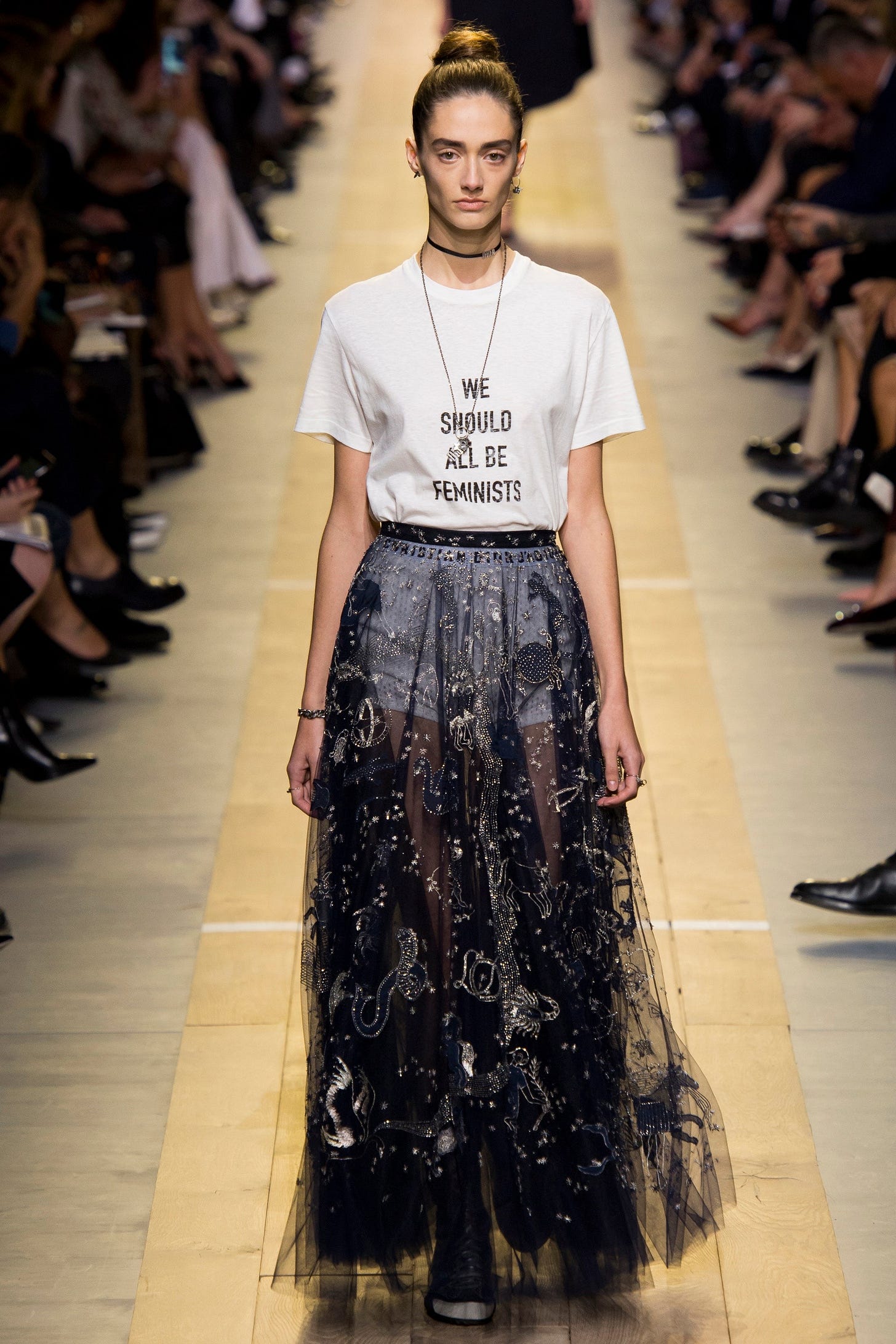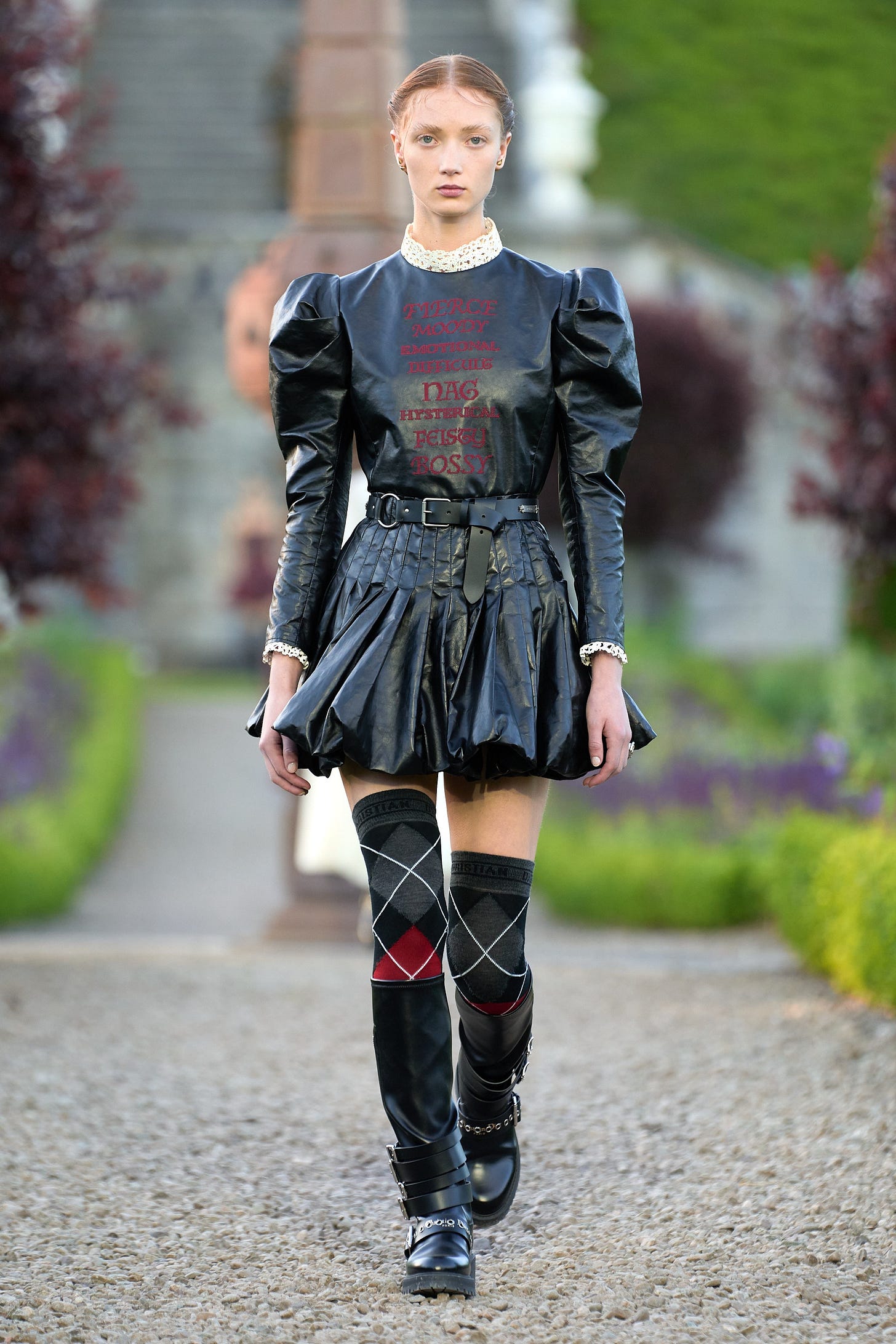For many, this is the primary association with Maria Grazia Chiuri’s tenure at Dior:
Along with other slogans, through the years: “Sisterhood Global,” “(Dior)evolution,” “Why Are There No Great Women Artists?” The t-shirt pictured above is emblazoned with the title of a Ted talk given by Nigerian author Chimamanda Ngozi Adichie: “We Should All Be Feminists.”1 My personal second association is YouTube fashion critic HauteleMode’s extreme distaste for her unfortunate tendency to slap a skinny black belt on everything.2 But with her recent replacement at Dior (she is speculated to have resigned in order to pursue her own brand) by Jonathan Anderson, I decided to comb through her work in order to give her a fair appraisal. Ultimately, while it is true that Chiuri had a few weak points— tone-deaf slogan tees and unnecessary belts being two— she is a very serious and and hardworking woman who unknowingly distills within her work the dissonance inherent in our popular conception of femininity. Chiuri’s Dior is an exhibition of “you can have both.”
That we think of “feminist” graphic tees when Maria Grazia Chiuri is invoked is a tragedy in its own right. Chiuri was born and raised in Rome, where she learned dressmaking from her own mother. She reminisced on Suzy Menkes podcast Creative Conversations about her mother’s close relationships with her clients, how they came to her mother in order to dress themselves, as they truly wanted to be. Clothing was for Chirui, from a young age, something that took design, fine materials, and hard work, and it was something that portrayed personality and formed identity. She was born in 1964, and so a little too young to have participated in the cultural upheaval of the late sixties, but remembers changes in popular women’s clothes as they fought for the right to no-fault divorce and abortion access. She states that, although she would consider her parents egalitarian and progressive, “they didn’t teach us about patriarchy in school in Italy. How the hell was I supposed to know?’”3 This belies the sort of rose-colored approach to girlboss feminism and wokism that Chiuri took— and I don’t deny that she possibly had some personal interests in these topics as well— in order to sell what was a floundering Dior fashion line to millennials.
Her vogue review for FW2017 states that she had an “underlying commitment to making Dior more relevant as realistic streetwear young women might want to pick up.” Interestingly, it is at precisely this that she failed. Or rather, I consider it a creative and artistic failure. Because the slogans did sell. After all, since 2016 we have been trying desperately to revive the power that slogans had in the sixties. There are still dingy “I Believe…” and “Black Lives Matter,” and “Women’s Rights are Human Rights,” signs stuck in yards around my neighborhood, almost always inhabited by a well-meaning and pleasant white lady who was dutifully taught about the patriarchy in college. And I do remember selling those Christian Dior bras and underwear, and the little logo ribbon heels, and the t-shirts. But as I was scouring the collections Chiuri designed for Dior, you can see that when she is able to shake off the pressure of speaking (selling) to a generation that she does not understand, her clothes are not streetwear at all. They are very aspirational, they are best when they are tailored and severe. She doesn’t do unpolished or casual well, as exhibited by Spring and Fall 2018 RTW, my two personal least favorites. It seems that in trying to “support this generation,” she lost her design bearings completely and showed a jumbled mess. Perhaps that’s all our generation can inspire.

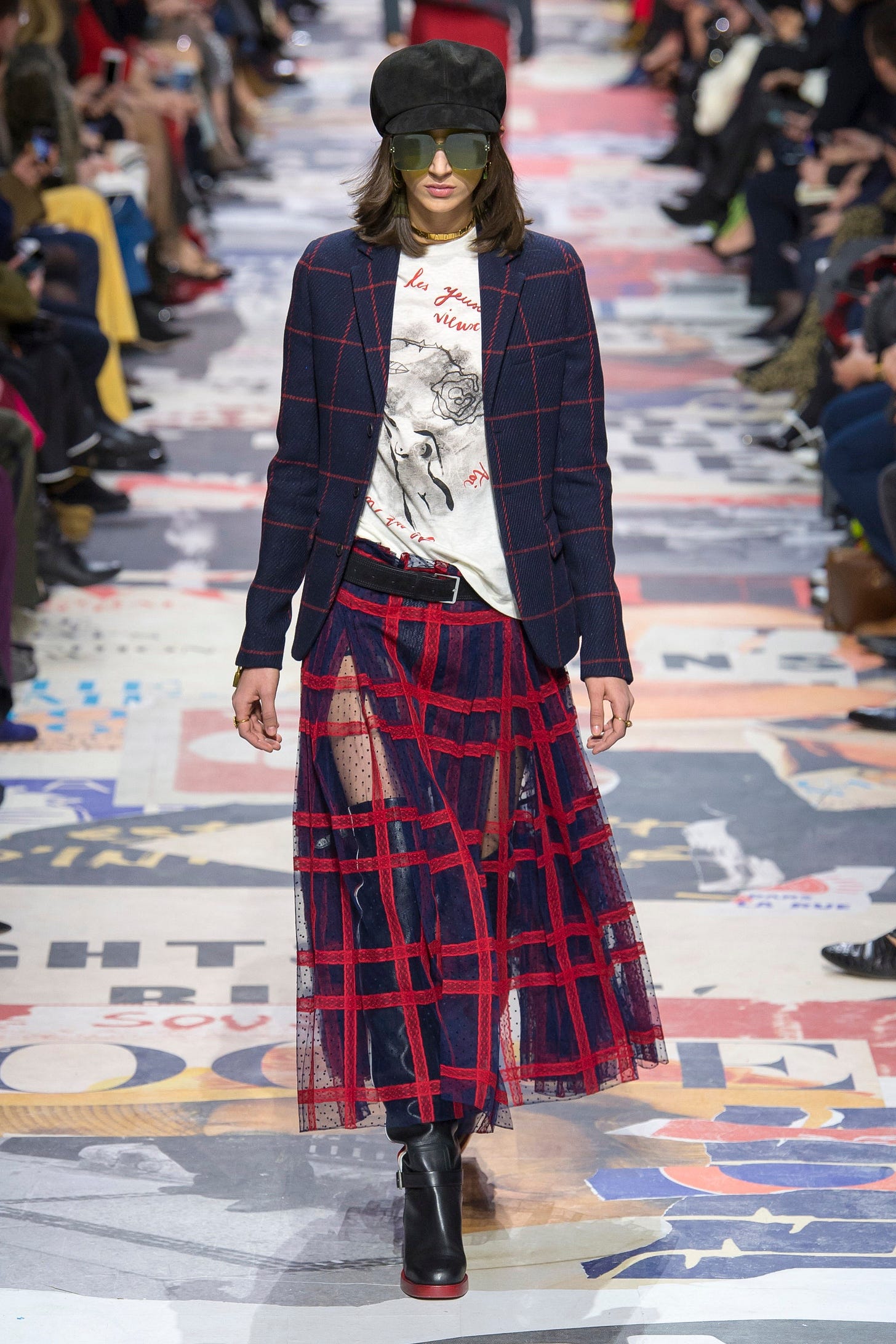
Chiuri fits in, perhaps, with the women about whom I wrote this piece4– women who admirably love being women, who live intentionally, and as a result have cultivated a sophisticated sense of taste and a refined view of relationships, who celebrate femininity, creativity, spirituality, restraint, but simultaneously aren’t really the type to question the narratives of progress that they are handed. They live by mottos like “nevertheless, she persisted,” but persist in nothing resembling the pursuit of truth. Chiuri champions many good things, handcrafts, heritage, history, and traditional textiles. She worked tirelessly to incorporate and revive dying arts into her work, especially for her cruise and resort shows. She shook off the tiresome accusations of cultural appropriation each time with receipts proving that local artisans had collaborated with Dior in the creation of fabrics, patterns, or had been consulted in the development of certain images or references. She believes one should be able to sew a garment, should have been properly and traditionally trained, in order to be the creative director of a fashion house. But she did not reflect on what femininity could look like for her younger customer. She does not ask the millennial and gen Z customer to do the work of forming an identity outside of the ego-stroking surety that they are on the right side of history. As a result, Chiuri designed in two entirely different ways; for her generation, her vision of femininity at Dior is full-fleshed, legible, strong. But when she designs for a younger woman, there is no vision. She is like an adult who stammers and blushes when a group of teenagers nearby start to whisper and giggle- intimidated, afraid of offending, and, above all, ready to accept their beliefs, on their terms.
These designs for her own generation are a rarity, but just look at how lovely it could have been:
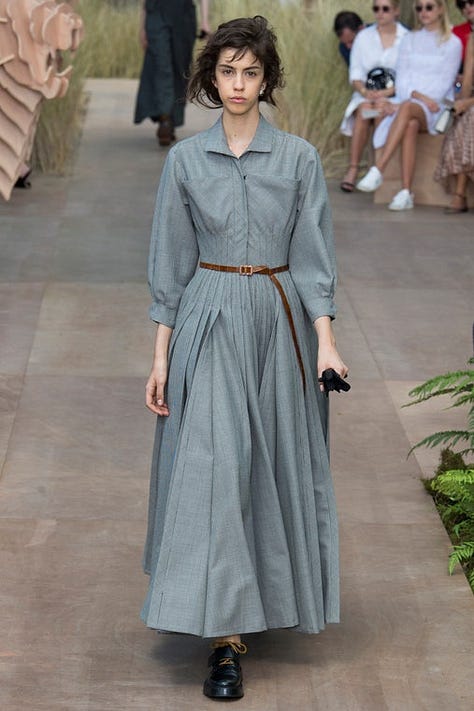
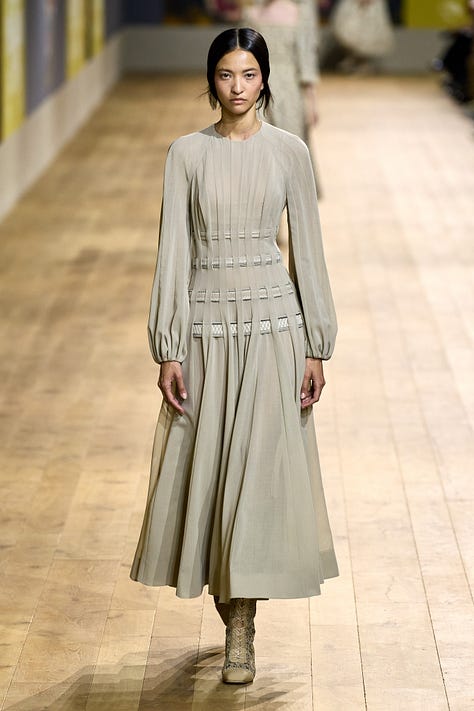
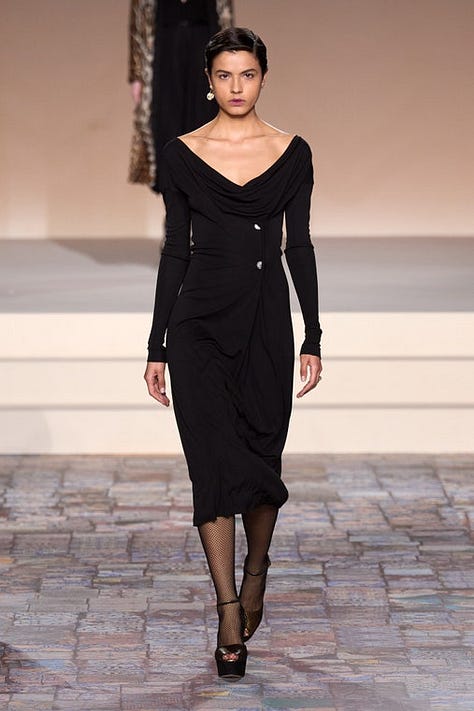
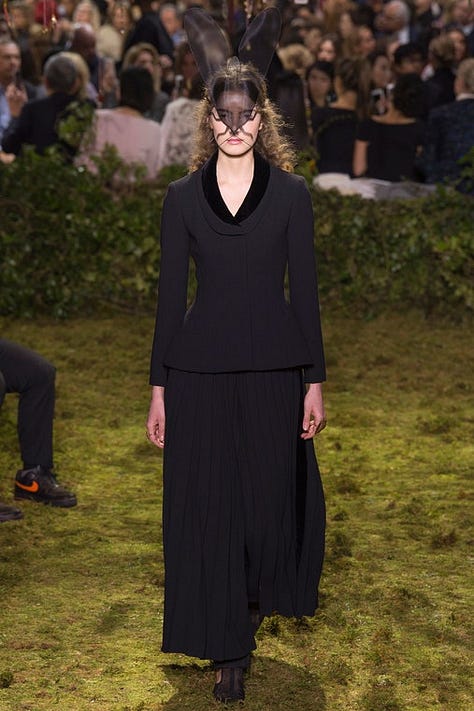


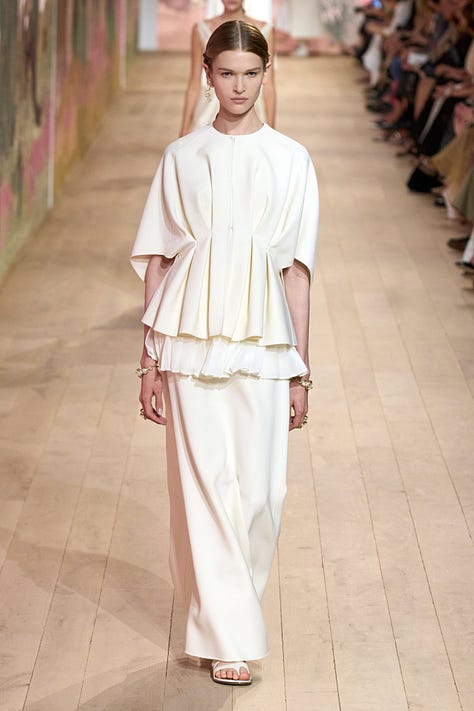


Her best work is consistently for Couture, but it also takes her a while to get there... Fall 2018 Couture is her first objectively good collection. It is very restrained, completely unironic. While there is little visual interest, it is clear that she focused on the work of making something well designed, elegant, and functional, all while looking to house codes.
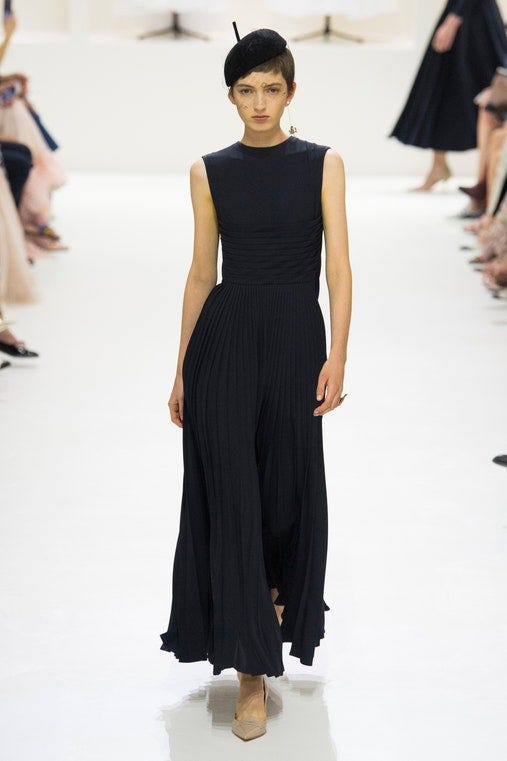

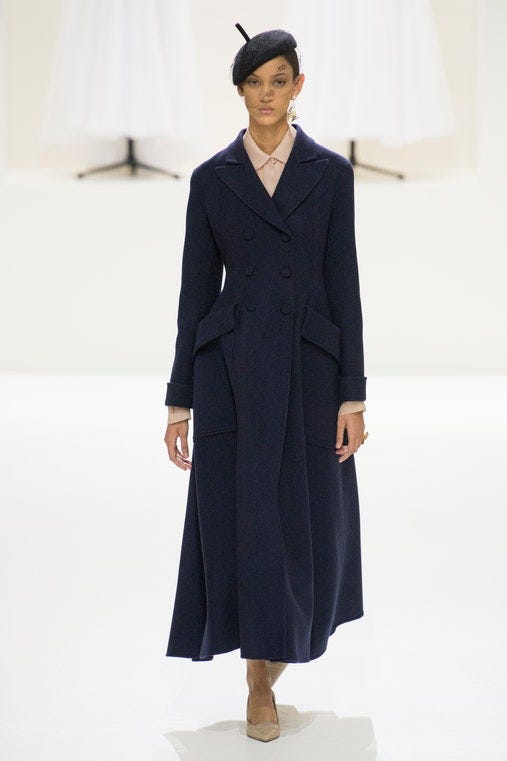
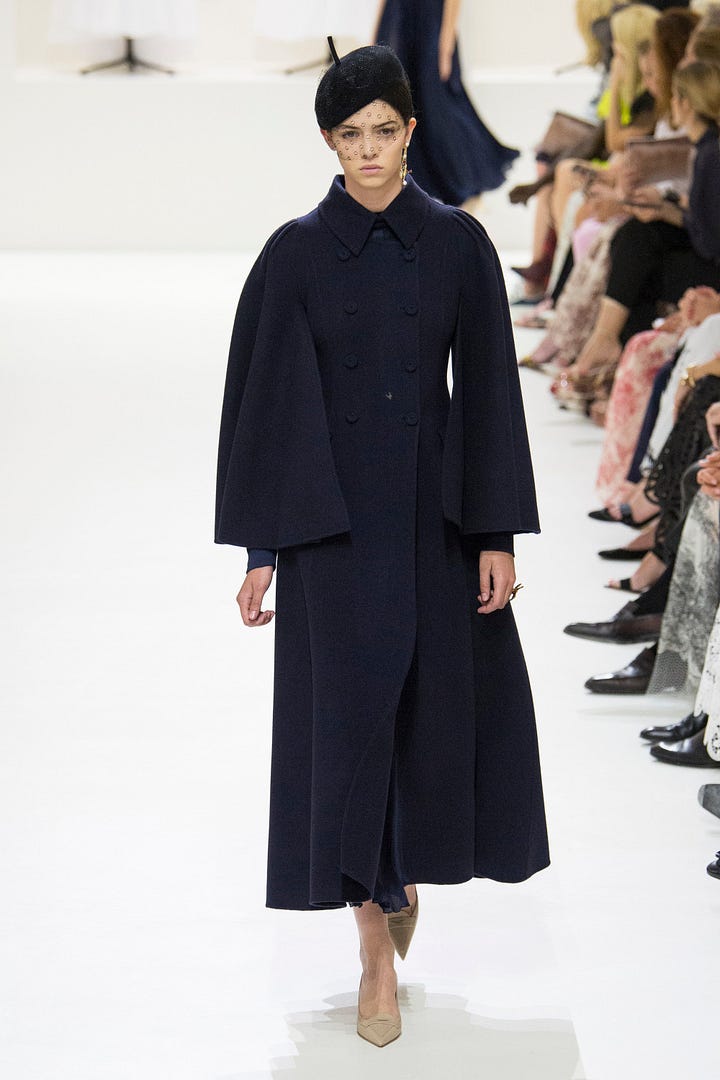
Her pre-fall 2020 collection names 9 tenants of fashion design, that she drafted herself.5 Here they are, with my comments in parentheses:
Fashion is Political. Fashion is Desire (two things that a paradoxically related and diametrically opposed. There is a lot of tension between what you should wear, and what you want to wear, what you would wear with the guard rails off. It is in respecting this tension that you arrive at a personal style identity that honors your singularity and your existence as just one of many.)
Fashion design occurs through the connection of communities, knowledge and visions (see #8)
The process of fashion design is a scientific discipline. (See #8)
Design has no hierarchies (here I disagree…. Everything has hierarchies. Scientific disciplines have hierarchies. The world is hierarchical by nature. This is where Chiuri’s work goes wrong. It is always in the struggle against the reality of womanhood that she makes bad clothes)
The body of fashion is abstract. The body of fashion holds trace of all types of bodies (Chiuri looks to sport in several collections for inspiration and seeks to “free the body,” rather than “build the body” via couture. I don’t necessarily mind this but her primary method of freeing the body is sheer tulle, which becomes a trope after its identical use in more than two consecutive collections. But she also at one point defends the use of thin models, explaining that she does not think a model should be so thin as to become ill, but that the thinness allows for the garment to be shown in its default state, and therefore actually helps the client picture how it would look on a wider variety of bodies.)6
Codes are the anchor points of the unceasing future (see #9)
Sustainability is designing timeless items that can be combined freely. (This is a nice sentiment but again, while Chiuri occasionally demonstrates her ability to design this way, the chokehold that “selling to millennials” and “modernizing the Dior woman” has on her makes this rather hypocritical).
Materials determine and alter shapes. (I appreciate the respect for design and the seriousness of her approach shown in #2, #3, #7, #8. She has spoken often about how sewing is a creative and artistic pursuit that is often considered “just” a domestic necessity, and how all women making fabric and clothes for their families throughout time were artists in their own right. See my other essay, Her Hands Hold the Spindle)
Knowing oneself means being aware of the tradition one comes from. (I agree… but why then is she embarrassed of where she came from? Looking at the vast majority of her work, the tradition that she seeks to honor is the spirit of the sixties; of looking to the youth for guidance and a disposal of generational wisdom, of swallowing the promise of progress hook, line, and sinker.)
Chiuri’s Dior woman is therefore a modern woman: a woman with no vision, whose life is a contradiction. A woman who, like the female founders of Leset (whose clothes I would love to wear around the house everyday, by the way) who see no inherent contradiction in donating simultaneously to Baby2Baby and Planned Parenthood. A woman who, like Chiuri, espouses (and profits) from intellectually lazy feminist talking points and radical gender studies ideas, while living happily at home with her husband and kids in a traditional, monogamous, marriage. She is basically living a Christian life. Christian-lite. Just like your neighborhood yard-sign lady.
What I appreciate about Maria Grazia Chiuri is her earnestness, her total lack of irony. She is so sincere in her effort to make two contradictory visions of womanhood compatible that she does not find one ounce of cringe in her slogan tees. They are just as dear to her as her impeccable tailoring. But was Maria Grazia Chiuri successful as a creative director? Her tenure was a decade of missed opportunities, a strange jumble in which she tries desperately to convince her younger customers that Dior is on the right side of history. The rare flashes of what she would create when she rid herself of this self-imposed political importance serve to remind us that fashion is only powerful as a political tool if it also excels in its artistic and practical purpose. If the Chiuri Dior woman was a national costume, which nation would you guess has women who truly “know themselves” and are “aware of the traditions from which they come?”
Also author of Americanah, Half of a Yellow Sun, and Dear Ijeawele: A Feminist Manifesto in 15 Suggestions. Americanah and Half of a Yellow Sun I remember enjoying the story and the writing, however, I read them rather indiscriminately as a college student and have not revisited them.
For example:
https://www.elle.com/fashion/a64516394/maria-grazia-chiuri-departs-dior-2025/




